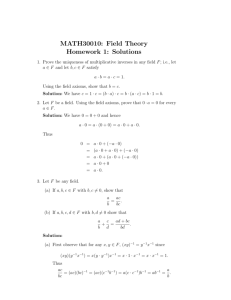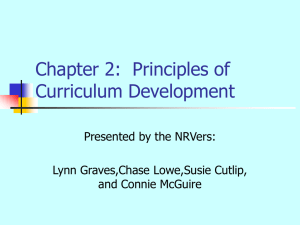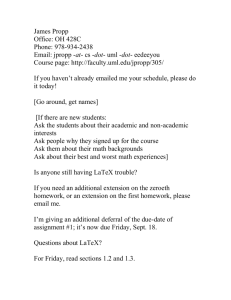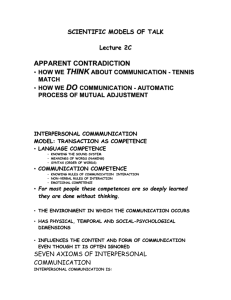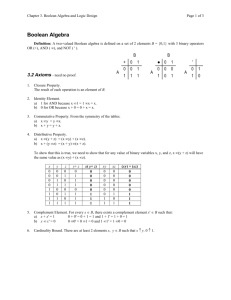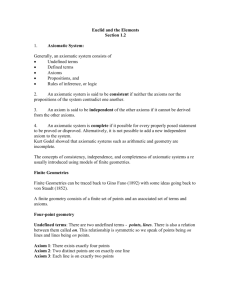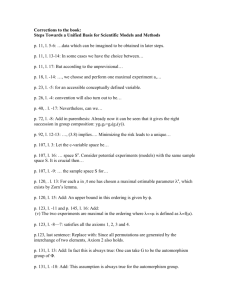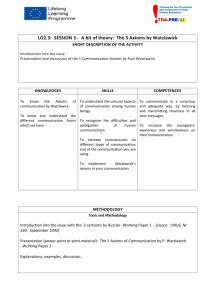MAT H 532, 736I: MODERN GEOMETRY
advertisement
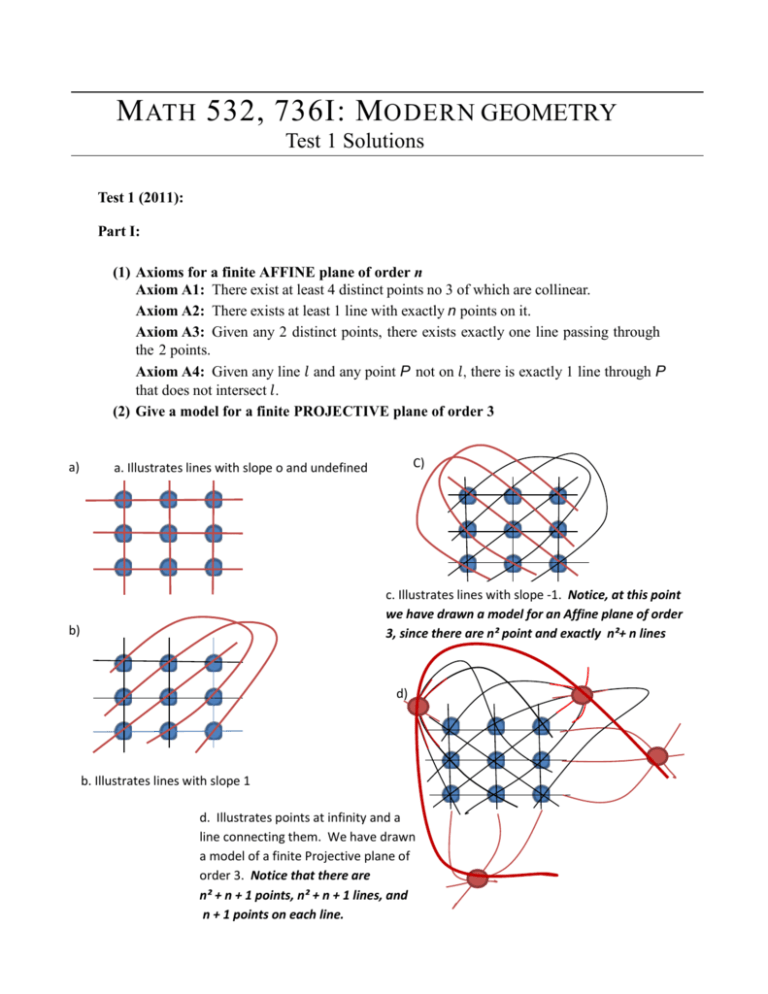
M AT H 532, 736I: M ODERN GEOMETRY
Test 1 Solutions
Test 1 (2011):
Part I:
(1) Axioms for a finite AFFINE plane of order n
Axiom A1: There exist at least 4 distinct points no 3 of which are collinear.
Axiom A2: There exists at least 1 line with exactly n points on it.
Axiom A3: Given any 2 distinct points, there exists exactly one line passing through
the 2 points.
Axiom A4: Given any line and any point P not on , there is exactly 1 line through P
that does not intersect .
(2) Give a model for a finite PROJECTIVE plane of order 3
a)
C)
a. Illustrates lines with slope o and undefined
c. Illustrates lines with slope -1. Notice, at this point
we have drawn a model for an Affine plane of order
3, since there are n² point and exactly n²+ n lines
b)
d)
b. Illustrates lines with slope 1
d. Illustrates points at infinity and a
line connecting them. We have drawn
a model of a finite Projective plane of
order 3. Notice that there are
n² + n + 1 points, n² + n + 1 lines, and
n + 1 points on each line.
(3) Two points have been circled in the
7x7 array of points to the right. Using
the model for a finite affine plane of
order 7 discussed in class, finish
circling the points that belong to the
same line as the given circled points.
(4) Consider the points (4, 2) and (10, 9) in an 11x11 array of points for our model
of a finite affine plane of order 11. Find the equation of the line passing
through these two points. Put your answer in the form
a. Find the slope of the line by using the slope formula:
You only need to use one point to find the k. However, for information sake, both are shown. By the
slope formula given above, we find m= 7/6. Note that 7 = 18 (mod 11) so we can use m = 18/6 = 3 for
the slope.
a) Using the point (4, 2)
𝑦
2
3𝑥
𝑘
3 4
2
b) Using the point (10, 9)
𝑦
𝑘
9
3𝑥
𝑘
3 0
𝑘
2
𝑘
9
30
𝑘
2− 2
𝑘
9 − 30
𝑘
− 0
𝑘
−2
𝑘
𝑦
Definition: if 𝑎
𝑏
𝑦
𝑘
𝑘
𝑚 , the m divides (a-b).
3𝑥
So we know that, −2
𝑘
⟹
𝑑𝑖𝑣𝑖𝑑𝑒𝑠 2
since k is in {0,1,...,10}
3𝑥
𝑘 ⟹𝑘
,
(5) Using only the theorem below and the axioms you stated in Problem 1, fill in
the boxes below to complete a proof that in an affine plane of order n, for
each line , there are at least n-1 lines parallel to . This is part of a proof
you were to have memorized for class. (More precisely, the problem you
were to have memorized for class involved showing that there are exactly n-1
such lines. I have not used the word “exactly” in my statement of the
problem above.)
Theorem: In an affine plane of order n, each line contains exactly n point.
Note: The theorem is to be used in the proof below. The proof is establishing that
there are at least n-1 lines parallel to as stated above.
Proof: Let
be an arbitrary line. By Axiom A₁, there is a point P₁ not on . By the
given Theorem, line
a line
has at least one point, say P₂, on it. From Axiom A₃, there is
passing through P₁ and P₂. Since P₁ is on
and not on , we have that
. Axiom A₃ implies that P₂ is the only point on both
Theorem,
has exactly n points on it, two of which are P₁ and P₂. Let P₃, …,
denote the remaining points on.
implies that there is a line
different from
(with
since
For each
passing through
is parallel to
and
2) are distinct by Axiom A₃ (since
any two of the
the lines
. By the given
with
2,
is not on so that Axiom A₄
and parallel to . Each such
is
is not. It follows that the lines
is the unique line passing through
). Thus there are at least n-1 distinct line parallel to (namely,
2).
Part II: The problems in this section all deal with an axiomatic system consisting of the
following axioms.
Axiom 1. There exist 3 collinear points (that is, 3 points and a line with the 3point on the line).
Axiom 2. There exist exactly 3 distinct lines.
Axiom 3. Given two distinct lines, there is at least one point on both lines.
Axiom 4. Given two distinct points, there is at most one line passing through them.
Note: Axiom 1 is saying that there exist 3 collinear points. This does NOT mean “exactly”.
There may be more points in the axiomatic system, and there may even be more point on the
same line as these 3 points.
1) Justify that the axiomatic system is consistent.
The model satisfies all the axioms
in the system, therefore the
axiomatic system is consistent
NOTE: this is just one model that
satisfies the axioms.
2) Justify that the axiomatic system in not compete. Include some brief explanation for your
answer.
The axiomatic system is not
complete because there
exist more than 1 model for
the system, and it is possible
for a theorem about the
system to hold for one
model but not for another.
Ie: in the model on the left
there exist 7 points which is
not true for the model on
the right.
NOTE: Because we can add at least one point to at least
one line when constructing our model , implies that we
can have as many points as desired. Although we need
only show two, there are infinitely many models.
3) Justify that the axiomatic system is independent.
A
B
Axioms 1,3,and 4 hold; axiom 2 does not
(ℓ is the only line that exists; therefore,
Axiom 2 is independent).
C
Axioms 2-4 hold, Axiom 1 does not.
(A, B, C are noncolinear; therefore,
Axiom 1 is independent.)
A
B
2
1
2
1
Axioms 1, 2, and4 hold; Axiom 3 does
not (no point on both ℓ₁ andℓ₂;
therefore, Axiom 3 is independent).
Axioms 1-3 hold; Axiom 4 does not (ℓ₁
and ℓ₂ both pass through A and B;
therefore, Axiom 4 is independent).
4) What is the dual of Axiom 3?
Dual Axiom 3: Given 2 distinct points, there is at least one line passing
through both points.
5) Justify that the principle of duality does not hold for this axiomatic system.
Because the system is not complete, we can use any model for the system
and show that the dual of one of the axioms does not hold for that particular
model and hence, the principle of duality does not hole for the entire system.
Using the information from question 4, the
A
B
C
D
6) Prove the following:
Given two distinct line, there is exactly one point on both lines.
Let
and
on both
be two arbitrary lines. By Axiom 3, there is at least 1 point
and
Since
. Assume that there is a point
are 2 distinct points with 2 lines,
also on
and
them, we get a contradiction to Axiom 4. Therefore,
both
and
and two lines intersect in exactly 1 point.
and
.
, passing through
is the only point on

